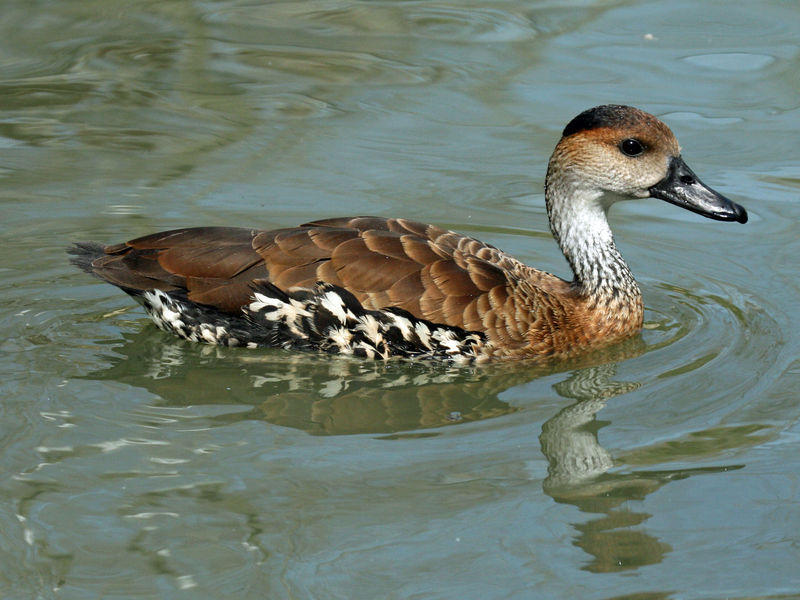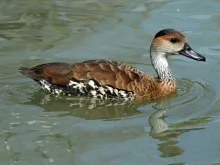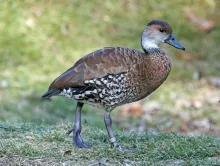
West Indian Whistling duck (Dendrocygna arborea)
Species name
- Dutch name:
- Cuba fluiteend
- English name:
- West Indian Whistling duck
- German name:
- Kubapfeifgans
- French name:
- Dendrocygne
- Scientific name:
- Dendrocygna arborea
Scientific classification
- Order:
- Anseriformes
- Family:
- Anatidae
- Onderfamilie:
- Dendrocygninae
- Genus:
- Dendrocygna
Description
- Description:
Male:
The male has a chestnut brown forehead, with a dark brown/black stripe from the crown down the back of the neck. Its face is pale ginger, fading to grey and white on the chin, throat and neck. The feathers on the back and tail are medium brown, as are the wings. The primary feathers of the upper wing have silvery buff patches on them. The duck’s sides and flanks are black with distinctive white mottling. They have a black Bill. Legs and feet are dark blue/black. In flight, the duck’s legs trail behind them and are longer than the tail.Female:
As male, though can be seen to be very slightly smaller When next to mate.Juvenile:
Duller and browner, less Rufous, then adults, with much-reduced black and white spotting and streaking on underparts, where black completely absent at first. Little or no Rufous on forehead and upper cheeks, and brown rather than black brown crown and nape, making head appear less marked.
- Behaviour:
Nest in loose groups. Loaf in small groups during the day. Form strong, probably permanent pair bonds.
Standard Measurements
- The male (drake) of the West Indian Whistling duck measures approximately centimeters. The female measures approximately centimeters.
- The male will weight about gram. The female will weight about gram.
The weight is notoriously variable and can only be used as indication!
- Note:
Whistling-ducks generally do well, either in pens or in a park with access to extensive water area and good natural cover. They are gregarious outside the breeding season, and groups may bully smaller duck species, so should be kept in large areas, in which other birds have room to escape. Most need shelter in severe weather and a well-sheltered pen with frost-free night quarters for winter is suggested, or plenty of ground cover and/or straw to stand on, as they are susceptible to frostbite. They may be kept fully-flighted in aviaries, and have also been kept full-winged in open pens, tending not to wander. Perches should be provided at an appropriate height for pinioned or wing-clipped birds. Commercial pellets and grain are suitable for feeding.
Elevated nest boxes are appreciated by most species, although pinioned birds will use ground-level boxes; boxes may be placed over water or land. Eggs may be incubated by bantams and ducklings may be bantam-reared. Many species have been successfully parent-reared in captivity. Pairs kept isolated and fully flighted in a covered pen, with high-hung nest boxes "seldom fail to rear broods". Whistling-duck species may hybridise with one another and therefore should be kept in separate enclosures, and hybridisation has also occasionally been reported with Rosy-billed pochard (Netta peposaca).
These whistling-ducks are relatively numerous in collections and are bred fairly regularly. They require much space, preferably a large lake, and a slightly-heated shelter is required in winter. Some individuals are very aggressive, particularly in the breeding season - they have been reported to attack and even drown swans. They may be fed wheat and standard pellets, together with green food such as lettuce, duckweed and grass.
West-Indian whistling-ducks are fairly easy to breed; breeding results are best with a single pair. Eggs may be laid in the cover of ground vegetation, or in a ground-level nest box. Laying begins usually May or June. Ducklings require warmth, but are otherwise simple to hand-rear. They will carry food to the water to eat and may get their plumage soiled with food. If given swimming water, there is a risk of chilling unless they are immediately warmed under the duck or a heating lamp.
These ducks may hybridise with Fulvous whistling duck (Dendrocygna bicolor) and Plumed whistling duck (Dendrocygna eytoni).
- Breeding:
- The female West Indian Whistling duck usually lays from 6-12 white eggs and incubates them for 28-30 days.
- Artificial incubating:
The ideal relative humidity for incubating most waterfowl eggs is 55% (ground nesters) and 40% (cavity nesters). The temperature is usually 37.4°C. Set ventilation as recommended by the incubator manufacturer. Eggs must be turned, either automatically or by hand, a minimum of 4 times a day. As the duckling develops there is a loss of water from the egg and the air sac gets bigger. In normal development of an egg with a 28-30 days incubation, the air sac occupies about a third of it three days earlier. Cleanliness is vital and ideally eggs should be moved to a separate hatcher at this point, where the humidity should be increased to 65% and even higher once they have pipped internally.
- Bird banding:
- Recommended closed leg band ring size for the West Indian Whistling duck is 13 mm.The leg band ring can only be applied on a young whistling duck at around 12-14 days old.
- It doesn't matter what leg that you band, but it's good to have a consistent system. Suggested: Left leg = Female, Right leg = Male


